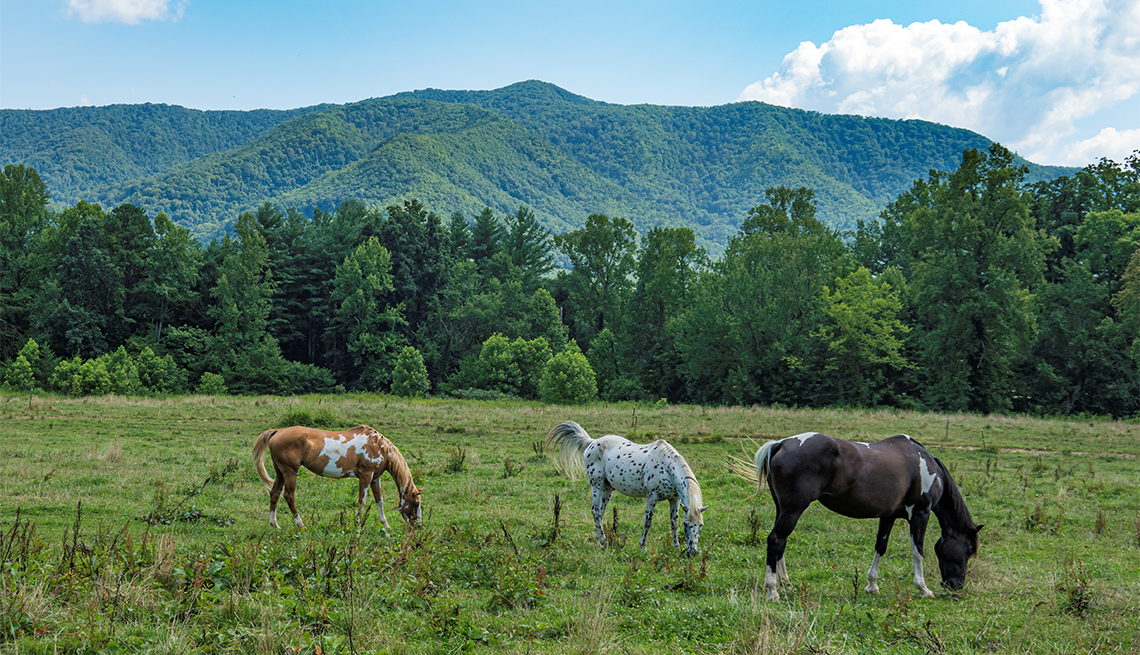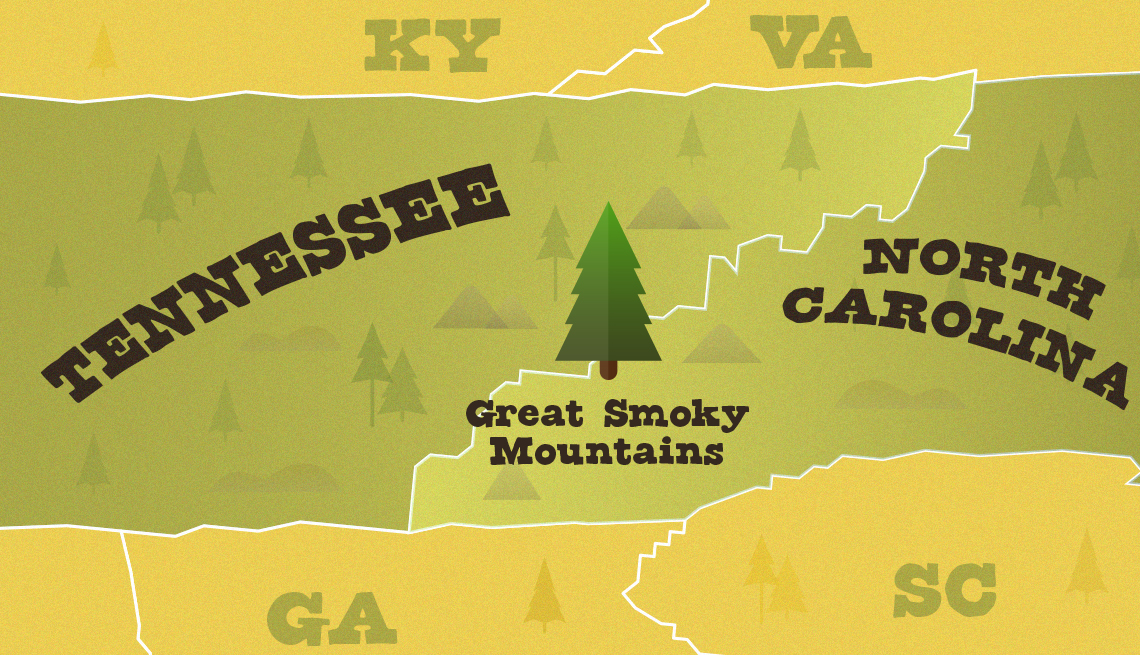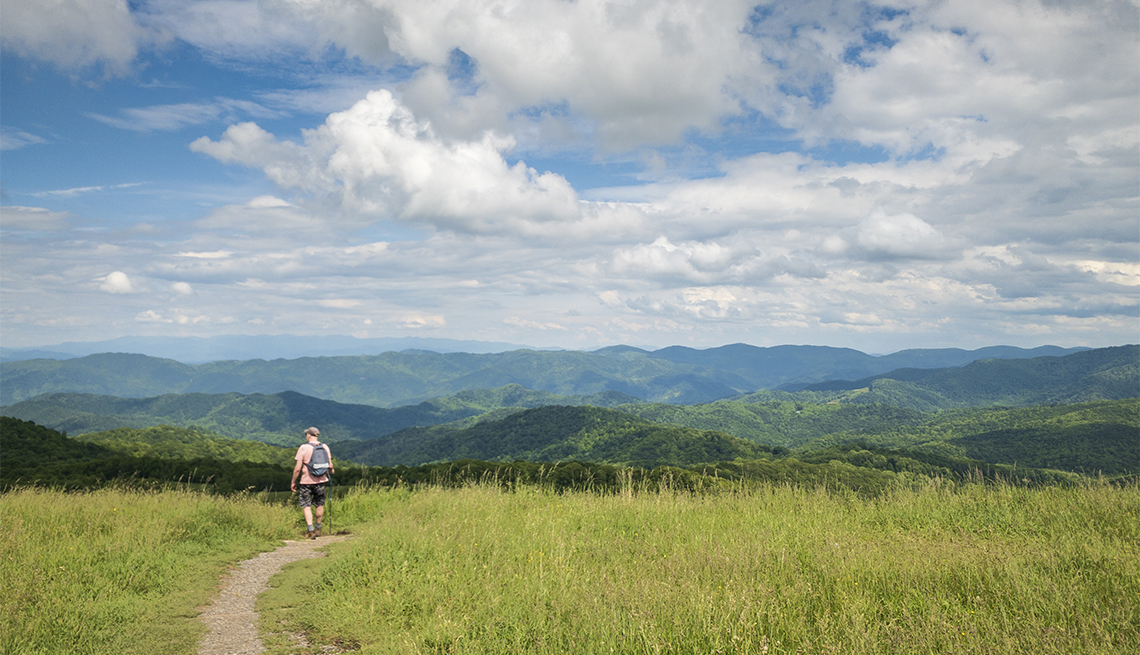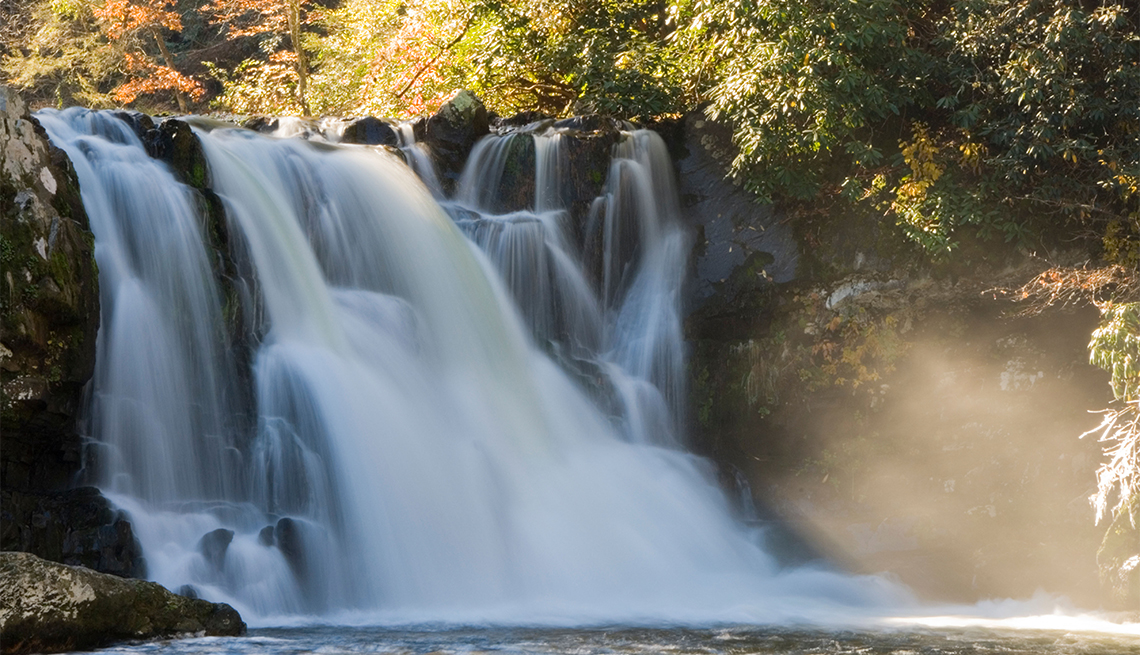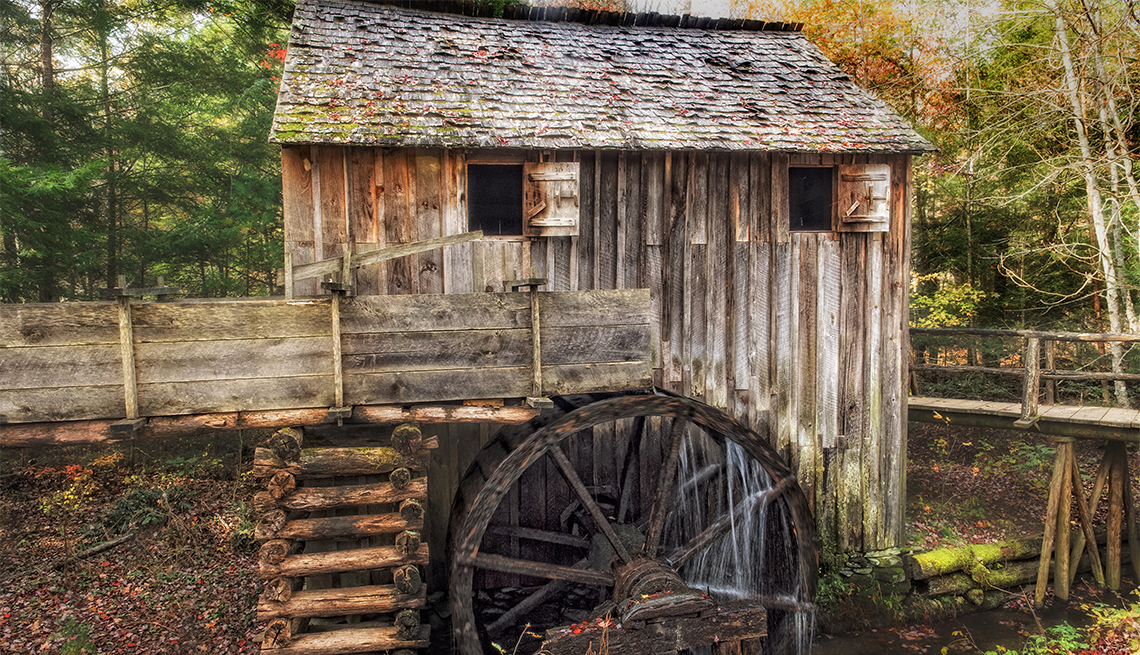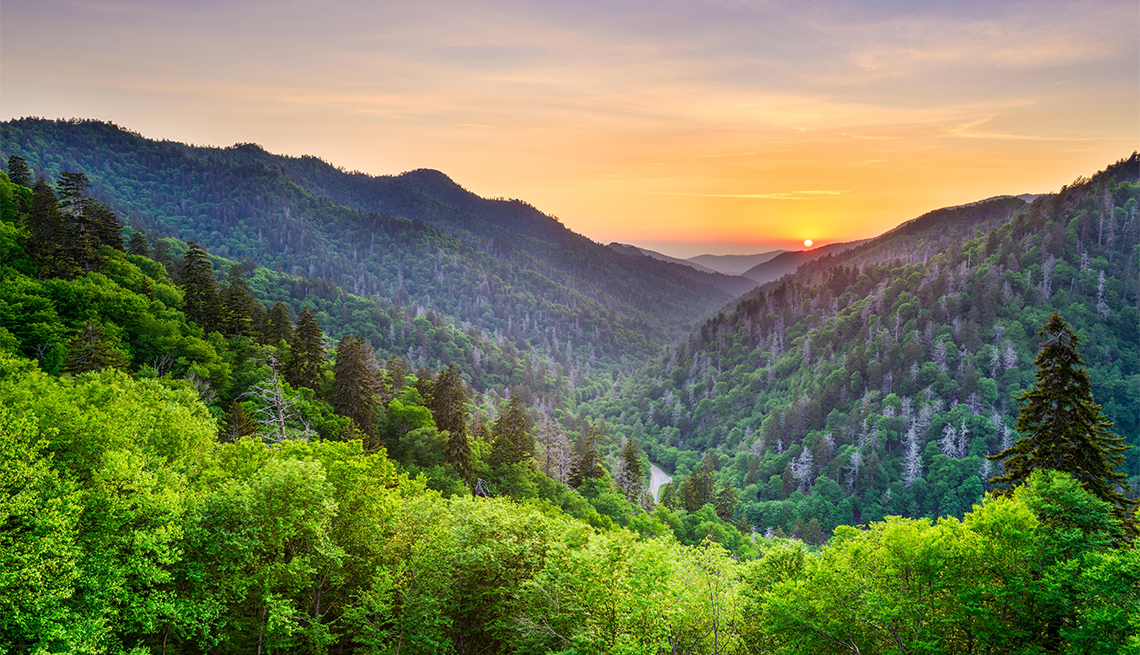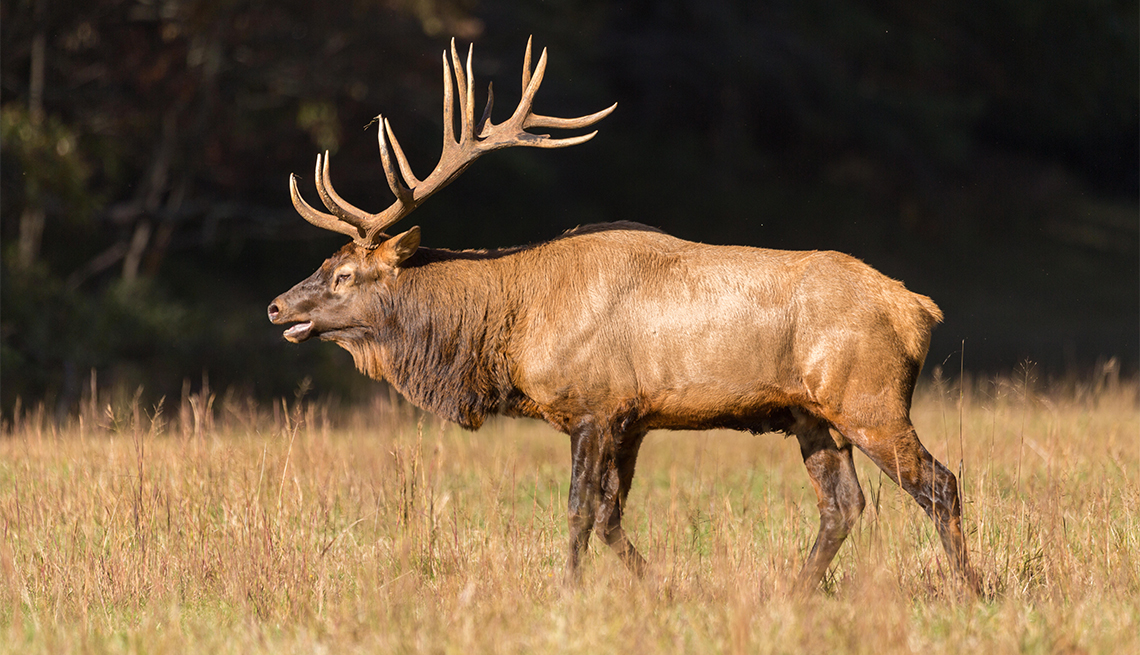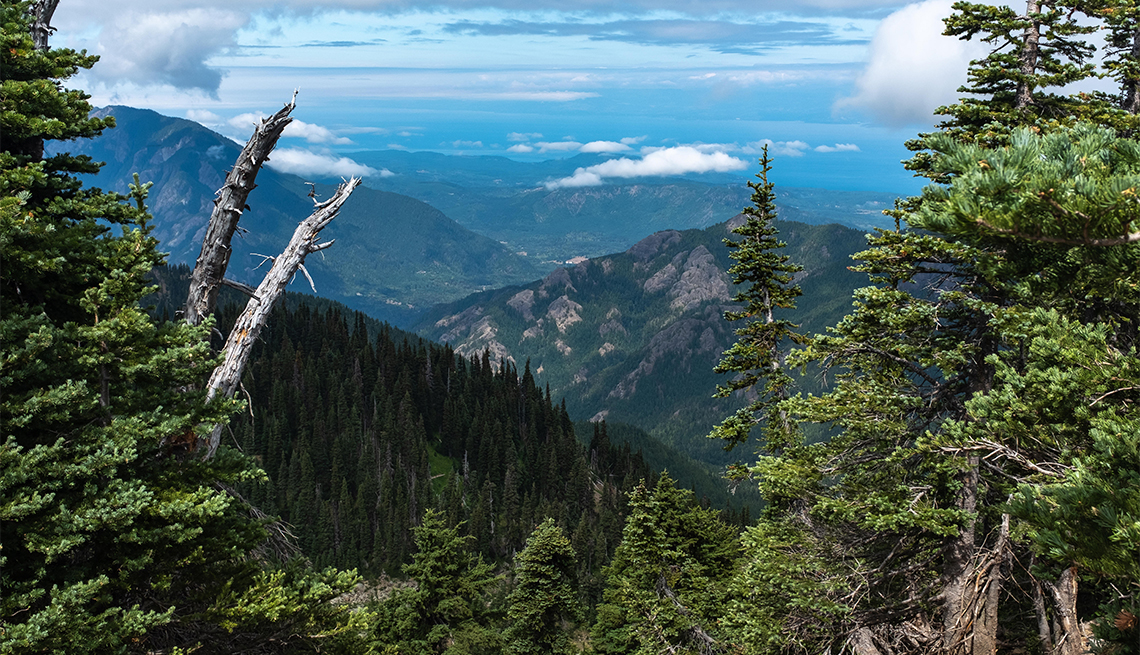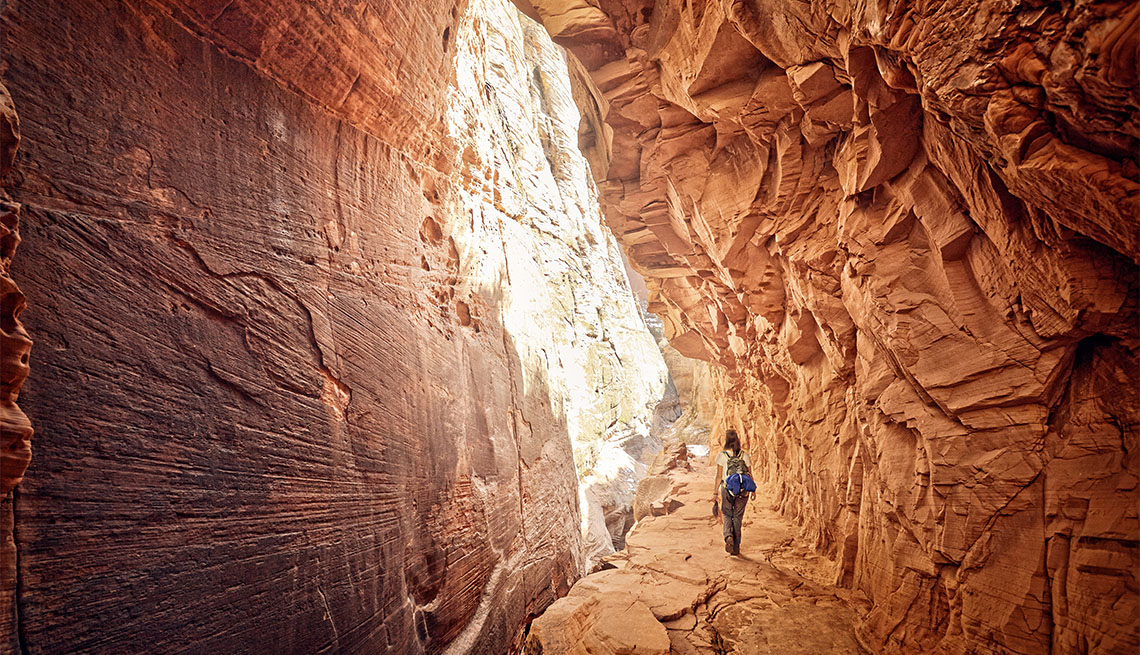AARP's Guide to Great Smoky Mountains National Park
Retrace the steps of the Cherokee on quiet nature trails and witness autumn's splendor in our country's most popular park
En español | It's not surprising that the Great Smoky Mountains is the most-visited of the nation's 62 national parks, welcoming more than 12 million visitors last year. Within driving distance of so many busy hubs in the eastern U.S., the massive natural expanse offers hard-to-match beauty with its unbroken chain of mist-shrouded mountain peaks rising more than 5,000 feet, meandering streams, cascading waterfalls, flower-strewn meadows and miles of old-growth forests.
Nearly evenly split between eastern Tennessee and western North Carolina, the park has 62 species of mammals — including iconic black bears, bobcats, coyotes, red wolves and an estimated 200 elk — roaming its 522,427 acres. It's also home to more than 67 varieties of fish, 234 species of birds and dozens of species of salamanders (the park has been called the “Salamander Capital of the World").
Members of the Cherokee Nation lived in these mystical mountains long before European settlers arrived — their roots here dating back more than 1,000 years. The ever-present fog circling the range prompted the Cherokee to name the mountains “shaconage,” which translates to “place of blue smoke.” Euro-Americans later dubbed them the Great Smoky Mountains.
Chartered by Congress in 1934 and officially dedicated by President Franklin D. Roosevelt in 1940, the Great Smoky Mountains National Park (GSMNP) offers near-endless outdoor fun — from hiking (you can find trails for all ability levels) to boating, cycling, fishing and horseback riding. You can also explore old farmsteads of the Appalachian people who once called these mountains home.
Location: Split nearly even between eastern Tennessee and western North Carolina
Acreage: 522,427 acres
Highest peak: Clingmans Dome, at 6,643 feet
Lowest point: Abrams Creek, at 876 feet
Miles/number of trails: 850 miles along 150 trails
Main attraction: Cades Cove
Entry fee: Free
Best way to see it: Along its well-maintained roadways
When to go for nice weather and fewer crowds: Just before mid-June and in September
Plan Your Trip
Three major Tennessee cities are within an easy drive from GSMNP: Chattanooga is 108 miles southwest; Knoxville, just 32 miles north; and Nashville, 194 miles northwest. From North Carolina, Asheville is just 37 miles east, and Charlotte is 151 miles southeast. Atlanta is 175 miles southwest. With their large airports, Atlanta and Charlotte make good entry points for those flying in from across the country.
Located 42 miles southeast of Knoxville, Gatlinburg serves as the gateway to the main entrance on the park's north (Tennessee) side, while the town of Cherokee leads visitors into the North Carolina sector on the southeast side. There's no need to pull out your wallet at the park entrances: GSMNP has no entry fee. Once inside, you'll find four visitors centers — Cades Cove, Clingmans Dome, Oconaluftee and Sugarlands — each providing park information and ranger-led programs. It's a good idea to start your visit at the Sugarlands center, just 2 miles from the Gatlinburg entrance, for a 20-minute orientation film that will give you a nice overview.
GSMNP has 384 miles of well-maintained roads — most are paved, but some are gravel. Just remember, you're in the mountains, so be prepared for many twists and turns, plus occasional steep inclines and declines. (Note that some secondary roads have restrictions on large vehicles such as buses, RVs and trailers.) The Newfoundland Gap Road winds 31 miles southeast from Gatlinburg to Cherokee, connecting the two gateways.
In spring, the resident 1,600-plus black bears emerge from their winter slumber; more than 1,500 species of wildflowers begin to bloom, blanketing the park in multichromatic splendor; and mating fireflies light up the night sky in brilliant synchronicity. Daytime temperatures average a pleasant 65 degrees, with nighttime lows of 45 degrees.
Peak season runs from mid-June through mid-August, when monthly visitor totals hover around 1.5 million. Temperatures peak, too, with highs often climbing above 80 degrees during the day. Summer afternoons often bring thunderstorms, with July being the wettest month. By nightfall, the temperatures drop to a comfortable average of 55 degrees.
The humid summer weather subsides in September, and crowds start to thin out. In October, even cooler temperatures arrive, usually ranging from 40 to 50 degrees, along with a new surge of visitors. When hues of red, gold and orange spill down from the mountain peaks to the forest floor, the park sees its second peak season. To view the autumn splendor without all the traffic, slip into the quieter North Carolina sector for a weekday visit.
Winter snow and ice close some of the driving routes, including the popular road to Clingmans Dome, the park's highest mountain (elevation 6,643 feet). But the area remains open for cross-country skiing, snowshoeing or a winter walk through the high-altitude spruce-fir forest.
Plan to unplug when visiting the park: There are no cell towers, making reception limited or nonexistent except at higher elevations where visitors can sometimes detect signals. Limited Wi-Fi may be available at some locations.
You'll find restroom facilities at visitor centers, campgrounds, picnic areas, Newfound Gap and Clingmans Dome. Don't expect facilities on the trails except for a portable toilet on the Grotto Falls Trail and primitive facilities at the Rainbow Falls trailhead.
Accessible programs span from ranger-led explorations of the intricate forest floor to tours highlighting the park's human history. You can explore much of the park by car, with pull-off parking available to view the surrounding landscapes and short trails for venturing a bit farther.
AARP Membership -Join AARP for just $12 for your first year when you enroll in automatic renewal
Join today and save 25% off the standard annual rate. Get instant access to discounts, programs, services, and the information you need to benefit every area of your life.
Where to Stay and Eat
If you want to stay overnight in the park, be prepared to give your quads quite the workout. Reaching the only in-park accommodations (besides camping) requires a 5.5-mile hike and physical endurance, but you're rewarded with stellar sunrises and sunsets and star-filled night skies. Designed for those summiting Mount Le Conte, the park's third-highest mountain (elevation 6,594 feet), the Mount Le Conte Lodge can host up to 60 overnight guests in rustic one-room cabins and multiroom lodges. Day-trippers can break here for lunch as well.
The park also maintains 10 campgrounds ($17.50 to $27 per night) for tents and RVs, in a range of inviting locales, from riversides to forests. All have restrooms, cold running water and flush toilets, but no showers or electrical or water hookups. Each site has a fire grate and picnic table. Reservations are required (recreation.gov) from May through October, with limited first-come, first-served sites also available from November through April.
Just 8 miles from the gateway town of Gatlinburg, Elkmont Campground is the GSMNP's largest and busiest camping destination, with 200 campsites, nine of them ADA-compliant (wide concrete driveways, raised fire rings and wheelchair-accessible picnic tables), alongside the Little River. A quieter alternative is Cosby Campground on the park's northeast side: It offers 157 campsites nestled under a canopy of hemlock trees and the feel of backcountry camping with frontcountry amenities.
Backpackers can access primitive backcountry sites with a reservation plus five drive-in horse camps with primitive camping facilities, and hitch racks provide easy access to backcountry horse trails. For backcountry permits ($4 nightly per person), call 865-436-1297.
You won't be eating lavishly here. GSMNP's only dining option is the snack bar at the Cades Cove Campground store, which serves breakfast items, sandwiches, pizza, soups, wraps and ice cream. You'll also find vending machines at visitors centers. It's best to bring your own food and enjoy one of the 12 picnic areas scattered throughout the park in forests and alongside rivers and creeks. They come with charcoal grills and picnic tables.
Things to Do
From hiking on 150 trails covering 850 miles to cycling, fishing and horseback riding, GSMNP delivers recreational options aplenty — for all fitness levels. Or take it easy and sightsee from the comfort of your car on highways and motor trails (one-way scenic loops) that showcase park highlights. On the Newfound Gap Highway, take advantage of numerous pullouts to marvel at the scenic vistas. Along the drive, stretch your legs and absorb nature's soundtrack on short, easy trails marked as “Quiet Walkways.” The 0.3-mile Balsam Point Quiet Walkway, slightly north of the Chimney Tops overlook, serves up views of the Steep Branch Creek and the west prong of the Little Pigeon River. Take a seat on a bench in the clearing and soak in the scenery.
And consider some must-sees and must-dos in both the Tennessee and North Carolina sides of the park:
In Tennessee: You don't have to go far beyond the main entrance for a leisurely walk in a forest. Just outside the Sugarlands Visitor Center, the easy 1.1-mile Fighting Creek Nature Trail gives you an introduction to the park's wildlife, with possible sightings of black bears, elk, whitetail deer and more.
If you're up for a longer, but still easy hike with plenty to keep you entertained, Patricia Kersey, of the Gatlinburg-based A Walk in the Woods guide service, recommends the 4.9-mile round-trip Little River Trail in the Elkmont area, about 6 miles west of the Sugarlands center. “It's a relatively flat, wide trail that follows the river,” she says, and “along with its natural beauty, there's a lot of human history to discover as you hike.” Those include ruins of former resort cabins from the 1920s, remnants of the area's history as a getaway for the Knoxville elite.
Or try the Roaring Fork Motor Nature Trail, which winds nearly 6 miles through old-growth forests alongside gurgling mountain streams. The trail begins 3 miles into the park from the Cherokee Orchard entrance, a little more than a mile east of the Sugarlands center. One mile before you get to the trail, stop at the Noah “Bud” Ogle self-guided 0.7-mile nature trail for a walking tour of an authentic mountain farmstead, with one of the park's last remaining, fully operational tub mills. Then, if you're up for more physical activity, tackle the 5.4-mile (round-trip), moderately strenuous hike to Rainbow Falls, which begins just beyond the farmstead. This rock-strewn path gains about 1,500 feet in elevation en route to the 80-foot-high cascading falls named for the rainbow that often appears in the mist.
Thirty miles west of the Sugarlands center, scenic beauty and abundant wildlife make Cades Cove the park's most popular area. An 11-mile loop drive winds through the cove and past early 19th-century homesteads, barns, churches and a fully operational gristmill harkening back to the Appalachian way of life. Hikers flock to Cades Cove to access popular trailheads, including the 5-mile (round-trip) moderate Abrams Falls hike that leads through a gorgeous pine-oak forest alongside Abrams Creek to the namesake 20-foot waterfall that cascades into a long, deep pool.
Clingmans Dome, near the park's center, straddles the state line between Tennessee and North Carolina. The road to the soaring mountain detours from Newfound Gap Highway about 7 miles south, taking you to within a half-mile of the namesake observation tower. If you're physically able, continue on foot for a steep uphill climb with a big payoff: stunning 365-degree views of the surrounding Smokies.
Want to go really gonzo and test your grit? Challenge yourself on Mount Le Conte, north of the Newfound Gap road near the park's center, where several trails lead to the 6,594-foot summit. On the Alum Cave Trail, the shortest and steepest, you'll hike up 5.5 miles, passing Mount Le Conte Lodge.
In North Carolina: Escape the crowds on the busier Tennessee side and relish in the Smokies’ wild beauty in the isolated Cataloochee Valley in the park's less-visited North Carolina section. Surrounded by mountain peaks, the valley once served as hunting grounds for the Cherokee. Later, one of the area's largest Appalachian settlements prospered here. Preserved late 19th-century and early 20th-century structures — including two churches, a schoolhouse and several cabins — reveal this history. Pick up a self-guiding tour booklet from a roadside box near the valley's entrance.
Black bears, deer, elk and other wildlife roam this peaceful valley. For the best chance of spotting elk, wildlife biologist Joe Yarkovich offers this insider tip: “Arrive about an hour before sunrise or a couple of hours before sunset.” For anglers, Cataloochee Creek teems with wild trout. Hike all or part of the moderate 7-mile Boogerman Trail loop for a restorative amble through lush old-growth woods and over the rushing waters of Caldwell Fork.
Experience the park's beauty from a different vantage point on Fontana Lake, on GSMNP's southern border, which gives you access to the park's most remote areas and the adjacent Nantahala National Forest. From one of several marinas, rent a pontoon boat for exploring on your own, or take a hiking tour via boat with Sunny Day Adventure Company. “Many trails surrounding the lake are relatively flat, which makes them accessible for most guests,” says Jason Swafford, the company's proprietor.
When the October peak season overruns the roads in other park sections, Swafford recommends this area for leaf-peeping and wildlife viewing. “Lake traffic dissipates in the fall, but that's actually one of the best times to be on the water.” There's a bonus for taking the road (or lake) less traveled, he adds: “Black bear sightings are likely as they come down from the treetops to feed on the roe left behind by spawning fish."
Gateway Towns
Gatlinburg, Tennessee: With a fun, Orlando-like theme park vibe — coupled with a country twang — Gatlinburg and the adjoining town of Pigeon Forge flaunt attractions of every variety. Ideal if you have grandkids in tow: Ripley's Aquarium of the Smokies, where a penguin cam keeps an eye on the tuxedo-clad charmers. Nearby, the Gatlinburg SkyLift Park's elevator whisks you up to the SkyBridge for some exhilarating (maybe nerve-racking for some) sightseeing at cloud level on this pedestrian bridge stretching 680 feet across a deep gorge, at a height of 140 feet. A Tennessee classic, Dolly Parton's Dollywood amusement park thrills with all the twists, turns and spins expected — all served with a heaping side of country music.
Lodging options in Gatlinburg and Pigeon Forge range from resorts to chain motels. On the high end, spoil yourself in a luxury suite at the Margaritaville Resort and Spa on the Pigeon River. For something budget-friendly, settle into one of the basic rooms (breakfast included) at the Greystone Lodge on the River, where you can use the town's trolley to easily access Gatlinburg's attractions (there's a stop across the street from the lodge).
Fuel up for a busy day of exploring at the Pancake Pantry, a longtime (since 1960) Gatlinburg favorite that serves a mouthwatering range of sweet offerings, such as Banana Pineapple Triumph pancakes topped with powdered sugar and whipped cream.
Cherokee, North Carolina: Located on the Cherokee Indian Reservation, the town of Cherokee focuses on the tribal nation. Revisit the 18th century at the Oconaluftee Indian Village amid re-creations of traditional Cherokee dwellings, sacred ritual sites and workshops. Delve deeper into the tribe's 11,000-year-old history through interactive exhibits and cultural displays at the Museum of the Cherokee Indian. For outdoor recreation and an adrenaline rush, go white-water rafting on the Nantahala River in nearby Bryson City.
Splurge on a luxury cabin complete with fireplace, hot tub and access to a private chef at Cherokee Mountain Cabins. Alternatively, the budget-friendly Cherokee KOA Campground rents both deluxe cabins (with full bathrooms and showers) and basic camping ones (with the use of the campground bathhouse). Roll the dice at Harrah's Cherokee Casino.
When hunger strikes, the family-owned Granny's Kitchen dishes up generous portions of classic Southern cuisine. Fill up on barbecue ribs, pork chops and black-eyed peas at the lunch and dinner buffet.
En Route
Traveling from Atlanta to Cherokee on U.S. Highway 23, a 16-mile detour along Georgia Route 384 North leads to Helen, Georgia, a charming mountain town that replicates a Bavarian alpine village (yes, in the Deep South). Stroll along its picturesque cobblestone streets and you'll find specialty shops showcasing everything from kitschy souvenirs to handmade candles, artfully blown glass and cuckoo clocks. For dining, sink your teeth into a hearty plate of schnitzel at the Heidelberg.
If you're coming from Asheville, carve out time to tour the opulent Biltmore Estate before leaving the city. Erected in the late 1800s for George Vanderbilt, grandson of Cornelius Vanderbilt, the lavish “country home” sits on a 125,000-acre tract south of town.
Add a few extra days, if you can, to explore the scenic Blue Ridge Parkway. The southern end of this 469-mile linear park begins just 0.2 miles outside GSMNP's Oconaluftee Visitor Center and extends into Virginia, connecting with Shenandoah National Park.
- |
- Photos
Editor's note: This article was originally published on August 20, 2020. It's been updated to reflect recent COVID-19 developments.

